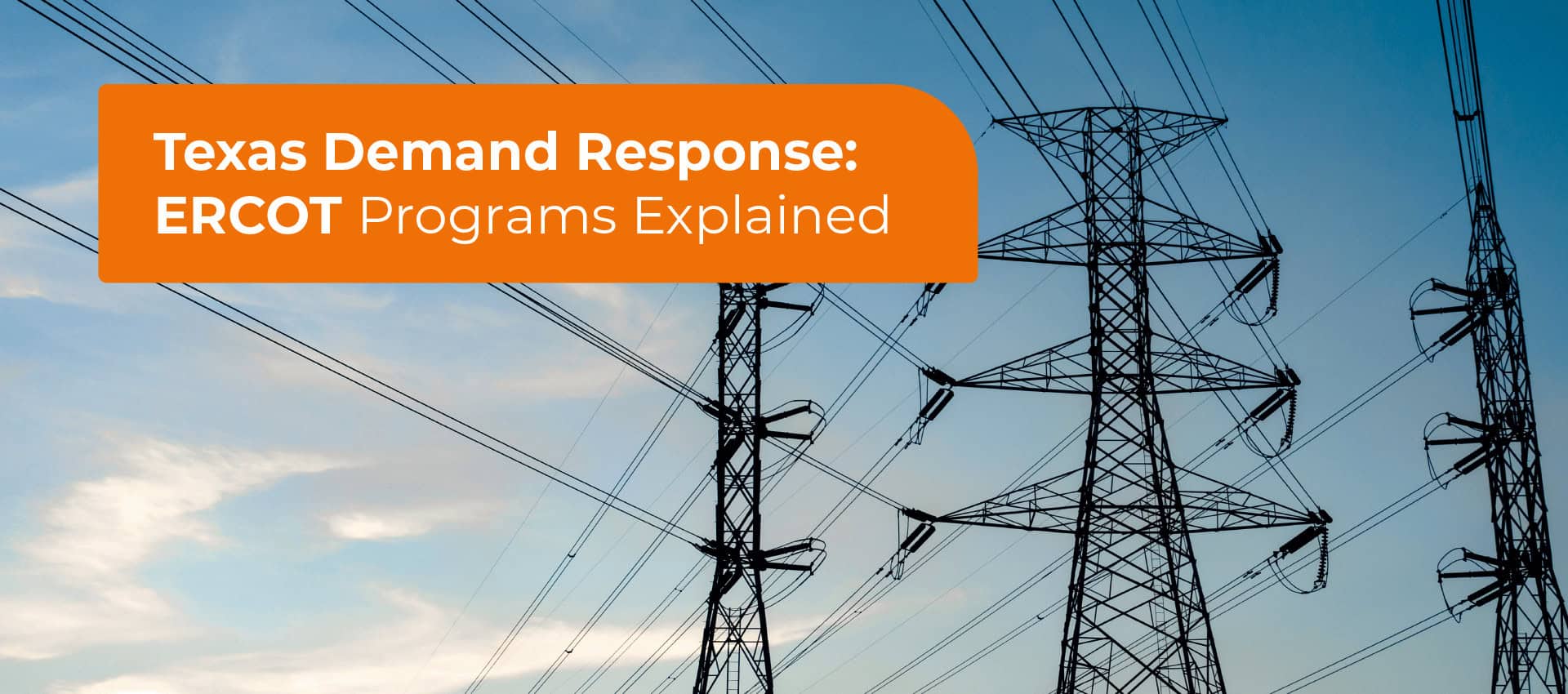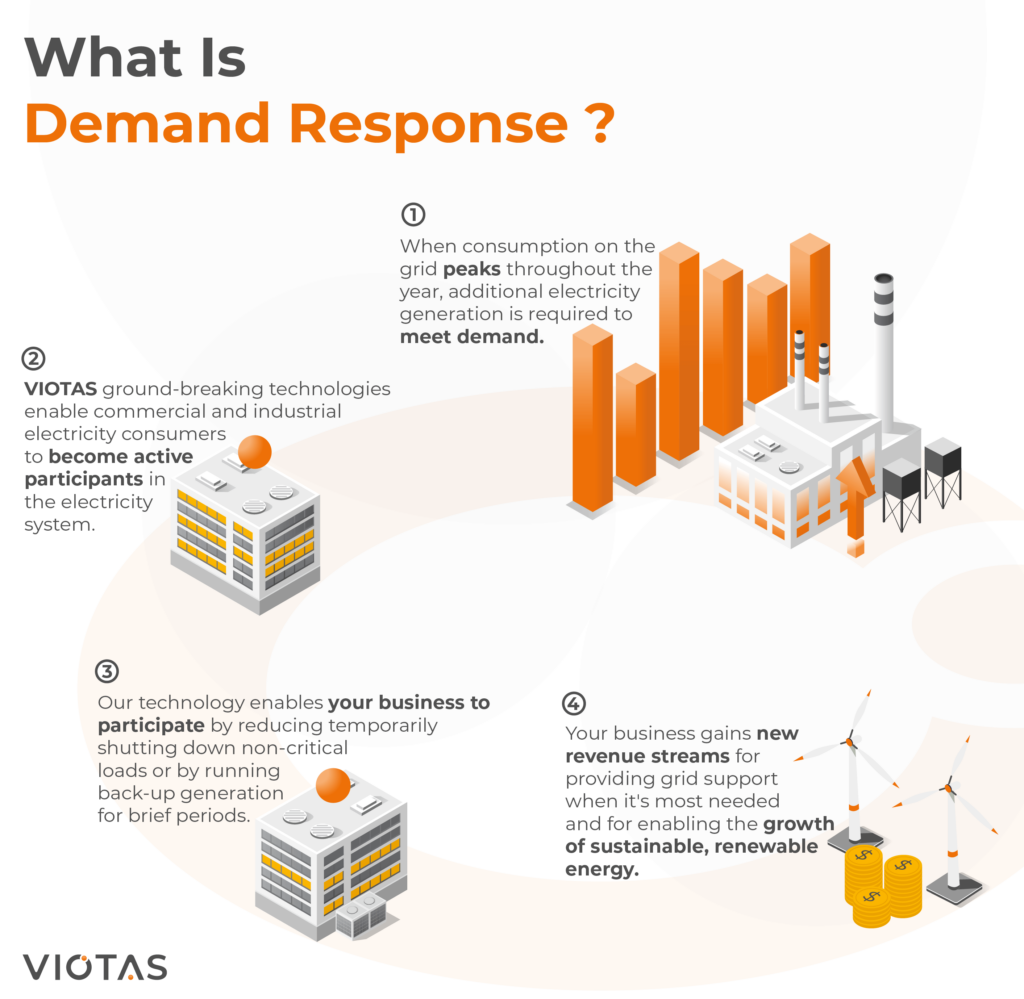
Texas Demand Response: ERCOT programs explained
In Texas, where energy demand fluctuates dramatically due to extreme weather conditions and high industrial activity, maintaining grid stability is critical. The Electric Reliability Council of Texas (ERCOT), which oversees the state’s power grid, has implemented a series of demand response programs to ensure reliable electricity supply. These programs incentivize consumers – especially large commercial and industrial users—to reduce or shift their energy usage during peak demand periods or in response to emergencies.
Through a combination of ERCOT-administered and non-ERCOT-administered programs, Texas has developed a robust demand response framework. This framework not only helps mitigate the risk of blackouts but also provides financial incentives for participants. The following article provides a comprehensive overview of the various demand response programs in Texas, their structures, and how they contribute to grid stability.
What is Demand Response?
Demand Response (DR) refers to the strategic reduction or shifting of energy consumption by customers in response to power grid conditions. It plays a critical role in stabilizing the grid during peak demand periods or emergencies, thus optimizing energy usage and reducing operational costs. In Texas, where the energy landscape is managed by the Electric Reliability Council of Texas (ERCOT), demand response programs are crucial due to the state’s significant and often volatile energy consumption patterns, particularly during extreme weather events like heat waves or winter storms.
By engaging in Demand Response, both residential and commercial customers contribute to grid stability and are often compensated through various financial incentives. The Demand Response initiatives enable the grid operator to manage sudden spikes in demand without resorting to emergency measures such as rolling blackouts.

ERCOT Demand Response Products
ERCOT has developed several demand response programs, each tailored to address specific grid needs and provide incentives for participants to reduce their electricity consumption during times of high demand or emergencies. Below is an overview of ERCOT-administered demand response products:
Summary Table of Demand Response Programs in Texas
| Program | Administrator | Purpose | Response Time | Eligible Participants |
|---|---|---|---|---|
| Emergency Response Service (ERS) | ERCOT | Grid emergency stabilization | ERS 10: 10 minutes ERS 30: 30 minutes WSL ERS: 30 minutes |
Industrial, Commercial, Aggregated Resources |
| Responsive Reserve Service (RRS) | ERCOT | Frequency response for major grid events | RRSUFR: Load with UFR trigger RRSFFR: Fast response |
Large Industrial, Generation, Load Resources, CLRs |
| Non-Spinning Reserve (Non-Spin) | ERCOT | Backup capacity for contingencies | NSPNM: Load Resources | Generation, Load Resources |
| ERCOT Contingency Reserve Service (ECRS) | ERCOT | Response to unexpected grid events | ECRS Load: During emergency conditions (EEA2) | Generation, Load Resources, Controllable Loads |
| Controllable Load Resource (CLR) | ERCOT | Real-time response to grid signals | Real-time adjustments | Controllable Load Resources (dynamic) |
| TDSP Load Management Programs | TDSPs | Peak demand management | Voluntary (during peak periods) | Large Industrial, Commercial Consumers |
| 4-Coincident Peak (4CP) Load Reduction | TDSPs | Peak reduction for lower demand charges | Targeted during top 4 peaks | Large Industrial, Commercial Consumers |
1. Emergency Response Service (ERS)
The Emergency Response Service (ERS) is ERCOT’s critical tool for managing grid emergencies. It enables participants to curtail load or provide power in response to grid instability warnings. The ERS program is designed to act swiftly, with participants compensated for their availability to reduce consumption during emergencies.
ERS consists of three primary products:
- ERS 10: This product is designed for rapid response, with participants required to deploy within 10 minutes of receiving an emergency notice. ERS 10 is a separate demand response product, not part of the daily ancillary services, making it an additional safeguard for extreme conditions.
- ERS 30: ERS 30 allows for a slightly longer response window, with participants required to deploy within 30 minutes of an emergency signal. Like ERS 10, this is a stand-alone product and is not part of ERCOT’s regular ancillary service offerings.
- WSL ERS: This Weather-Sensitive Load (WSL) ERS involves aggregations of residential loads that can be curtailed in emergencies. It is particularly useful during weather-related events, where residential demand surges.
ERS Deployment Conditions: ERCOT may deploy ERS when the Physical Responsive Capability (PRC) falls below 3,000 MW and is not expected to recover within 30 minutes following the deployment of non-spinning reserves. ERS-10, ERS-30 and WSL ERS are triggered through an XML message followed by a VDI to the QSE Hotline, and their ramp periods begin at the completion of the VDI.
Both products play essential roles in ensuring grid stability during unexpected demand surges or system failures, helping to mitigate the need for rolling blackouts or other drastic measures.
2. Non-Controllable Load Resource Participation in ERCOT Ancillary Services
ERCOT offers multiple ancillary services where load resources (customers who can reduce consumption play a critical role. These services maintain the reliability of the grid by providing fast responses to grid imbalances.
2.1. Responsive Reserve Service (RRS)
The Responsive Reserve Service (RRS) is a key frequency response service, designed to respond quickly to significant drops in grid frequency that could lead to system-wide issues. Load resources and generation assets can participate in RRS, and several variations of this service are available:
- RRSUFR: Traditional load resources provide this form of RRS, triggered by a UFR (Under Frequency Relay) at a frequency of 59.70 Hz. This service is subject to proration, meaning it is adjusted based on the actual need during an event.
- RRSFFR: This is a new fast frequency response service, available to both generation, CLRs (Controllable Load Resources), and LRs. It has a UFR frequency trigger of 59.85 Hz and is also subject to proration and competition with RRSUFR.
RRS Deployment Conditions: ERCOT may declare an Emergency Energy Alert (EEA) Level 2 when system frequency falls below 59.91 Hz for 15 consecutive minutes, or when PRC drops below 2000 MW and is not expected to recover within 30 minutes. ERCOT will issue deployment instructions via XML message followed by a Hotline VDI to begin a ten-minute deployment.
2.2. Non-Spinning Reserve (Non-Spin)
Non-Spinning Reserve is an ancillary service that provides backup capacity through both offline generation resources and load resources that can be quickly brought online when needed. There are several variations:
- NSPNM: This is a new Non-Spinning Reserve product that is available exclusively to Load Resources. It is deployed through control room instructions (via XML), and Load Resources’ Under-Frequency Relay (UFR) must be disabled for participation.
Non-Spin Deployment Conditions: Non-Spin capacity is deployed under several grid stress conditions:
- When the High Ancillary Service Limit (HASL) minus generation and Intermittent Renewable Resource curtailment, minus the 30-minute net load ramp is below 0 MW.
- When the PRC drops below 3,200 MW and is not expected to recover within 30 minutes without reserve deployment.
- When PRC drops below 2,500 MW, all available Non-Spin capacity is deployed.
2.3. ERCOT Contingency Reserve Service (ECRS)
The ERCOT Contingency Reserve Service (ECRS) is designed to handle unforeseen grid emergencies by ensuring backup capacity is available. It includes two key components: ECRS-Gen (generation resources) and ECRS Load (ECRSM) (load resources).
- ECRS Load (ECRSM): ECRSM allows Non-Controllable Load Resources (NCLRs) to provide ECRS in addition to participating in RRS. NCLRs providing both services should respond to under-frequency events as though they are providing only RRS, but they can be deployed simultaneously for both services as long as their capacity limits are respected. Similar to RRSUFR, ECRSM is manually deployed during an EEA2 event, and the resource is expected to curtail its obligation in 10 minutes.
ECRSM Participation Conditions: An NCLR can also participate as a stand-alone LR for just ECRS. In such cases, the relay does not need to be armed. There are separate instructions for those with relays armed and disarmed.
2.4. Controllable Load Resource (CLR) Participation in Ancillary Services
Controllable Load Resources (CLRs) can be dynamically adjusted in response to grid conditions. Unlike NCLR’s, CLRs allow for real-time adjustments to their consumption based on direct signals from ERCOT, contributing to services like frequency regulation and other ancillary services. This makes CLRs particularly valuable as they offer both flexibility and immediacy in responding to grid needs. CLR’s are allowed to provide the same Ancillary Services available to generation units including:
- RRSPFR: Responsive Reserve Service – Primary Frequency Response
- ECRSS: ERCOT Contingency Reserve Service – Supplemental)
- NSPN-: Non-Spinning Reserve
- URS: Up Regulation Service
- DRS: Down Regulation Service
3. Non-ERCOT Administered Programs
Besides ERCOT’s direct programs, other demand response initiatives in Texas are offered by Transmission and Distribution Service Providers (TDSPs) and other market participants. These non-ERCOT programs offer additional avenues for demand management, helping to spread the responsibility for grid stability across multiple layers of the market.
3.1. Transmission and Distribution Service Providers (TDSP) Load Management Programs
TDSPs in Texas administer their own load management programs, particularly targeting large commercial and industrial users. These programs typically offer incentives for reducing consumption during peak demand periods, thus alleviating strain on the grid. Participation in TDSP programs can also help businesses lower their demand charges, providing a financial incentive to reduce energy use when the grid is most stressed.
3.2. 4-Coincident Peak (4CP) Load Reduction
The 4-Coincident Peak (4CP) program is one of the most impactful demand reduction initiatives in Texas. Under this program, businesses are incentivized to reduce their load during the four highest peak-demand intervals each year. These peaks often occur during summer, when air conditioning demand skyrockets. By reducing load during these peak times, businesses can substantially lower their transmission charges for the following year. The program not only benefits participants through cost reductions but also plays a significant role in easing the burden on the grid during its most strained periods.
Demand response programs are essential for maintaining grid stability in Texas, offering both operational flexibility and financial incentives to businesses. These programs, from ERCOT-administered services to non-ERCOT initiatives, allow companies to reduce energy costs and support the grid during critical times.
As demand for energy continues to rise and renewable energy becomes more integrated into the grid, the need for efficient demand response solutions will grow. Companies like VIOTAS play a key role in this evolving landscape, providing businesses with the tools and expertise to optimize their participation in demand response, ensuring a more stable and sustainable energy future for Texas.



